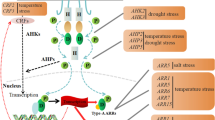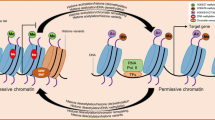Summary
Using different sources of protoplasts and two complementary techniques, flow cytometry and image analysis, to study the cell-cycle phases, we sought to define the particular protoplast state associated with the disposition to divide. Both inPetunia and inNicotiana plumbaginifolia, tissues with a higher G2 frequency (from different aged plants) yielded protoplasts capable of increased cell division. InSorghum, the age of the plant does not modify the proportion of G2 nuclei in leaf protoplasts, and we used root protoplasts to increase G2 frequencies. InHelianthus annuus, leaf protoplasts did not divide; however, hypocotyl protoplast preparations with relatively high 4C DNA frequencies do divide. Moreover, image analysis of chromatin structure indicated that leaf nuclei were in the G0 phase, unlike those from hypocotyls which were in G1. A high frequency of protoplasts with G2 nuclei appears to be correlated with the ability of a given preparation to undergo division; conversely, the differentiated G0 state is not conducive to division.
Similar content being viewed by others
References
Bergounioux-Bunisset C, Perennes C (1980) Transfert de facteurs cytoplasmiques de la fertilité mâle entre 2 lignées dePetunia hybrida par fusion somatique. Plant Sci Lett 19: 143–149
Bergounioux C, Perennes C, Miege C, Gadal P (1986) The effect of male sterility on protoplast division inPetunia hybrida. Cell cycle comparison by flow cytometry. Protoplasma 130: 138–144
Bohorova NE, Cocking EC, Power JB (1986) Isolation, culture and callus regeneration of protoplasts of wild and cultivatedHelianthus species. Plant Cell Rep 5: 256–258
Brugal G, Chassery JM (1977) Un nouveau système d'analyse densitométrique et morphologique des préparations microscopiques. Histochem 52: 241–258
— (1984) Image analysis of microscopic preparations. Meth Achiev exp Pathology, pp 1–33. S Karger, Basel
Cassel AC, Barlass M (1976) Environmentally induced change on the cell walls of tomato leaves in relation to cell and protoplast realease. Physiol Plant 37: 239–246
Cavallini A, Cionini PG (1986) Nuclear DNA content in differentiated tissues of sunflower (Helianthus annuus L.). Protoplasma 130: 91–97
Chassery JM, Garray C (1984) An iterative segmentation methode based on a contextural color and shape criterion. IEEE Trans. Pattern analysis and machine intelligence. 6: 794–800
Darzynkiewicz Z, Sharpless T, Staino-Coico L, Melamed M (1980) Subcompartments of the G1 phase of cell cycle detected by flow cytometry, Proc Natl Acad Sci USA 77: 6696–6699
Davey MR (1983) Recent developments in the culture and regeneration of plant protoplasts. Experientia [Suppl] 46: 19–29
Dela Torre C, Navarette MH (1974) Estimation of chromatine patterns at G1, S and G2 of the cell cycle. Exptl Cell Res 88: 171–174
Firoozabady E (1986) The effects of cell cycle parameters on cell wall regeneration and cell division of cotton protoplasts (Gossypium hirsutum L.). J Exp Bot 37: 1211–1217
Fakan S, Hernandez-Verdun D (1986) The nucleolus and the nucleolar organizer regions. Biol Cell 56: 189–206
Galbraith DW, Harkins KR, Madox JM, Ayres NM, Sharma P, Firoozabady E (1983) Rapid flow cytometric analysis of the cell cycle in intact plant tissues. Science 220: 1049–1051
— (1984) Flow cytometric analysis of the cell culture and somatic cell genetics of plants (Vasil IK). 1. Academic Press, New York, pp 765–777
Giroud F (1982) Cell nucleus pattern analysis: Geometric and densitometric featuring, automatic cell phase identification. Biol Cell 44: 177–188
- (1986) L'analyse d'images au service des morphologistes: paramétrisation de la texture de la chromatine et classification non supervisée des cellules. Application à l'étude de la prolifération cellulaire. Cahiers de L'INSERM (in press)
-Gauvain C,Seigneurin D (1986) A quantitative analysis of the human bone marrow erytroblastic cell lineage using samba 200 image processor. II. Chromatine texture changes related to proliferation and maturation. Cytometry (submitted)
Gray JW, Cofineau P (1979) Cell cycle analysis by flow cytometry. In: Meth in Enzym 58: 233–248
Lenee PH, Chupeau Y (1986) Isolation and culture and sunflower protoplasts (Helianthus annuus L.): Factors influencing the variability of cell colonies derived from protoplasts. Plant Sci 43: 69–75
Ludy Davey MR, Cocking EC (1983) A comparison of the cultural behaviour of protoplasts from leaves, cotyledons and roots ofMedicago saliva. Plant Sci Lett 3: 87–99
Luthe DS, Quatrano RS (1980) Transcription in isolated wheat nuclei. Plant Physiol 65: 305–308
Magmen E, Dalschert X, Faraoni-Sciamanna P (1982) Transmission of a cytological heterogeneity from the leaf to the protoplasts in culture. Plant Sci Lett 25: 291–303
Petit P, Conia J, Brown SC, Bergounioux C (1986) Cytométrie et biotechnologie végétable. Un avenir prometteur. Biofutur 51: 128–139
—,Perennes C, Bergounioux C, Seve AP, Delmotte F, Monsigny M (1986) Quantitative analysis of sugar-binding proteines in plant cell nuclei by flow cytometry. Biol Cell 58: 15 a (Abstr.)
Tabaiezadeh Z, Bunnisset-Bergounioux C, Perennes C (1984) Environmental growth conditions of protoplast source plants: effect on subsequent protoplast division in two tomato species. Physiol Veg 22: 223–229
Tall M, Watts JW (1979) Plant growth conditions and yield of viable protoplasts isolated from leaves ofLycopersicon esculentum andL. peruvianum. Z Pflanzenphysiol 92: 207–214
Vermar RS (1980) The duration of G1, S G2, and mitosis at four different temperatures inZea mays L. as measured with3Hthymidine. Cytologia 45: 327–333
Weber G, de Groot E, Schweiger HG (1986) Synchronization of protoplasts fromGlycine max (L.) Merr. andBrassica napus (L.). Planta 168: 273–280
Xu ZH, Davey MR, Cocking C (1982) Callus formation from root protoplasts ofGlycine max. (soybean). Plant Sci Lett 24: 117–121
Author information
Authors and Affiliations
Rights and permissions
About this article
Cite this article
Bergounioux, C., Perennes, C., Brown, S.C. et al. Relation between protoplast division, cell-cycle stage and nuclear chromatin structure. Protoplasma 142, 127–136 (1988). https://doi.org/10.1007/BF01290869
Received:
Accepted:
Issue Date:
DOI: https://doi.org/10.1007/BF01290869




